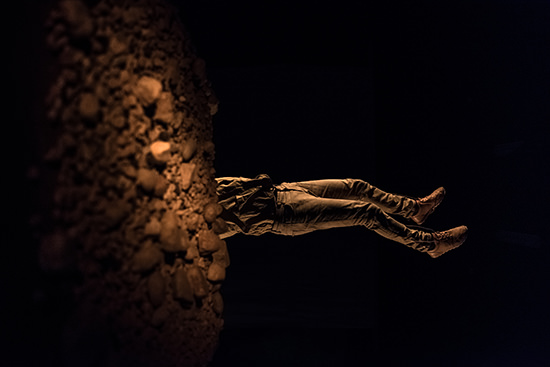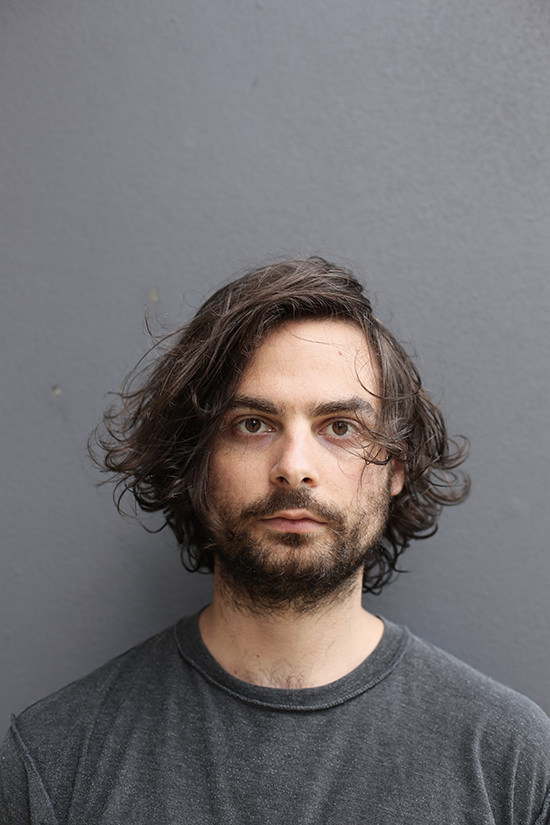Taking on the panic machine
Keith Gallasch: interview Tim Darbyshire, Stampede the Stampede

Stampede the Stampede
Tim Darbyshire, one of Melbourne’s most idiosyncratic dance artists, is in-residence for two weeks at Campbelltown Arts Centre re-immersing himself in Stampede the Stampede, a solo work he premiered at Dance Massive 2015. He tells me by phone that the residency is allowing him to recapture the work’s spirit and to experiment with possible changes. At the residency half-way mark, a substitute dancer will take on Darbyshire’s role, providing the artist with a short-term opportunity “to zoom out and take a look at the picture from the outside” before resuming his role for the 19-20 August performances.
Catch a glimpse of the magic of Stampede the Stampede here, ponder the title in which “stampede” as verb and object doubles—or dismisses—panic and note in the publicity a reference to a performance staged “within a turbulent yet controlling choreographic apparatus.” Although a solo work, Darbyshire sees his choreography as extending to set and lighting (Jenny Hector, Bosco Shaw) and sound (Madeleine Flynn and Tim Humphrey), such that they are performers too.
Stampede the Stampede looks to be a work about extreme involuntarism for performer and possibly audience, hence a description of the work as “[a] stampede of the senses.” In More or Less Concrete, a work that impressed me in Dance Massive 2013, Darbyshire used low lighting levels, slow sculptural movement and headphone sound to induce sensory confusion to great effect (see Keith Gallasch, “Dance and disorientation”). Of that work Darbyshire wrote in his program note, “The bodies are abstracted as they transform between human, animal, monster, machine and ‘other’.” Very little sense of agency was evident in these bodies; they moved as if primally and organically driven.
Involuntarism seems central to Stampede the Stampede—you and your collaborators have created a device that buffets you about. When I saw More or Less Concrete in Dance Massive 2013, its three figures appeared to have no agency, functioning cellularly or mechanically. A stampede is a state of panic, doubly so in the work’s title. What is it about lack of agency and involuntarism that preoccupies you?
I guess I’m trying to work out what that grey area is, the paradox of [agency versus] very mechanised and controlled, prescribed environments or prescribed choreographic structures. In the case of More or Less Concrete, a lot of that prescription came from the sound. It was almost like we three dancers were figures enslaved to it or moving surfaces in the creation of sound. And that leads into trance-like states. The sound in that work was driving the structure. In Stampede the Stampede, it’s the mechanics of the kinetic structure we’ve made that govern the body.
For this project there were many weeks focused on the development and implementation of the machinery, the mechanical elements, with the body kind of waiting in line—waiting to be activated. And in that waiting time, there’s a natural rebellion—the body reminding us that it’s there, that it’s an animal and it has a different kind of energy. That’s what I’m looking at, that kind of paradox between pre-determined mechanical structure and then the animality and rebellion of the free-willed body.
So there is a sense of rebellion in the work; you’re not just battered and panicked. You’re stampeding the stampede, panicking it, banishing it?
For a long time in the early stages of development I was particularly focused on the determinacy of the mechanics and imagined that the body was more or less a cog in the machine or like a crash test dummy—completely passive. I had fantasies of the machinery moving the body throughout the entire show. There was no free will at all. Then towards the end of the period, I became interested in the middle-ground and changing the ratio: the body as both passive crash test dummy and rebellious animal.
How much energy does it take from you to get through a performance? Reviewers have noted the extreme stress you appeared to be enduring.
A lot of it is about putting the body on the line because I’m working so fundamentally with ideas around rupture, rebellion and turbulence—volatility—and the body is a part of all of that. My body does take a battering but we’ve implemented precautions and ways to protect it. We’ve gone through most of the material this week and at the moment I’m feeling quite good, a little bit sore and tender in places, but not like the first season. We’ve implemented strategies to allow me to survive the work.
How deeply does this work reflect your feelings that we live in a constricting and buffeting time?
I’m in a very privileged situation. I’m a white Australian male who hasn’t had any horrendous things happen to me or my family. I feel very lucky generally speaking. It’s when zooming out—and I don’t have to zoom out very far to see the issues faced by people around me, within Australia and around the world—situations of real political and social turbulence as well as environmental disasters. All of these are catastrophic situations. Where do I put myself? My position is one of not knowing what to do or how to react. I have a sense of empathy, but a very limited one. In making this work, I put myself inside that chaos—albeit very superficially—figuring out from a performative, a choreographic perspective, what is the grain of that experience.
While reviewers have praised Stampede the Stampede, some were uncertain about the unconventional nature of your choreography. How do you feel about that?
In the broader spectrum of experimentation I need to stay true to my exploration, about being a very passive body, a dead weight, one in reaction to the machinery functioning around me. I’d also say that I consider the sound and the mechanical structure to be performers in themselves. I’m taking the definition of choreography outside of the body and into the spaces of kinetic objects and architecture.
In the development time, I needed to hold myself back a lot from creating choreography in the traditional sense. There were times when I thought I needed to make movement phrases and rhythms and do something more along the lines of More or Less Concrete. But I had to keep reminding myself that there was a whole other layer of meaning I have to stay in check with.

Tim Darbyshire
Tim Darbyshire, Stampede the Stampede, Campbelltown Arts Centre, 20-21 August; bookings here.
Watch a trailer for Stampede the Stampede, read a RealTime interview with Tim Darbyshire about More or Less Concrete and a review of that show by Carl Nilsson-Polias.
Tim Darbyshire studied Dance at Queensland University of Technology, graduating in 2003. His education continued through programs including DanceWEB (Scholarship recipient in 2006 and 2009), Formation d’artiste choréographique at Centre National de Danse Contemporaine (France 2006-2007) and Victoria University’s Solo Residency program (2008). He has worked with many choreographers including Vera Mantero, Emmanuelle Huyhn, Nuno Bizarro, Meg Stuart, David Wampach, Marianne Baillot, Antonio Julio, Christine de Smedt, Eszter Salamon and Shelley Lasica.
RealTime issue #134 Aug-Sept 2016






